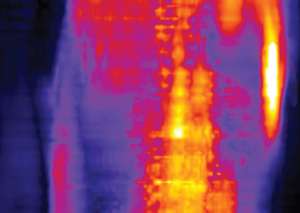Exposing breast cancer using nanoscale polymers

Photoacoustic imaging is a ground-breaking technique for spotting tumors inside living cells with the help of light-absorbing compounds known as contrast agents. A*STAR researchers have now discovered a way to improve the targeting efficacy and optical activity of breast-cancer-specific contrast agents using conjugated polymer nanoparticles.
Generating photoacoustic signals requires an ultrafast laser pulse to irradiate a small area of tissue. This sets off a series of molecular vibrations that produce ultrasonic sound waves in the sample. By 'listening' to the pressure differences created by the acoustic waves, researchers can reconstruct and visualize the inner structures of complex objects such as the brain and cardiovascular systems.
Diagnosing cancer with photoacoustic imaging requires contrast agents that deeply penetrate tissue and selectively bind to malignant cells. In addition, they need a high optical response to near-infrared laser light, a spectral region that is particularly safe to biological materials. Traditional contrast agents have been based on gold and silver nanostructures, but the complex chemical procedures needed to optically tune these nanocompounds have left researchers looking for alternatives.
Malini Olivo and her colleagues from the A*STAR Singapore Bioimaging Consortium and the A*STAR Institute of Materials Research and Engineering investigated different contrast agents based on conjugated polymers. These organic macromolecules, which contain alternating double and single carbon bonds, have delocalized electrons in their frameworks that can produce useful optical properties such as photoluminescence. The researchers identified a conjugated polymer known as PFTTQ—a compound with multiple aromatic rings, alkyl chains, sulfur and nitrogen atoms—as a promising in vivo photoacoustic agent because of its biocompatible structure and light absorption that peaks in the near-infrared range.
To direct this contrast agent to cancer cells, the team synthesized 'dot'-like nanostructures with an inner core of PFTTQ surrounded by water-soluble polyethylene glycol chains, terminated by an outer layer of folate molecules—a vitamin that specifically binds to folate receptor proteins commonly expressed by breast cancer tumors. Experiments with MCF-7 model breast cancer cells implanted in mice revealed the merits of this approach: in just one hour after administering the folate–conjugated polymer dots, strong photoacoustic signals emerged from the tumor positions. The folate functionality played a critical role in this bioimaging procedure, quadrupling the photoacoustic signals compared to unmodified PFTTQ dots.
"The folate–PFTTQ nanoparticles have great potential for diagnostic imaging and other biomedical applications," says Olivo. "We are working to expand the library of biocompatible polymers to use as molecular photoacoustic contrast agents."
More information: "Molecular photoacoustic imaging of breast cancer using an actively targeted conjugated polymer." International Journal of Nanomedicine 10, 387–397 (2015). dx.doi.org/10.2147/IJN.S73558




















